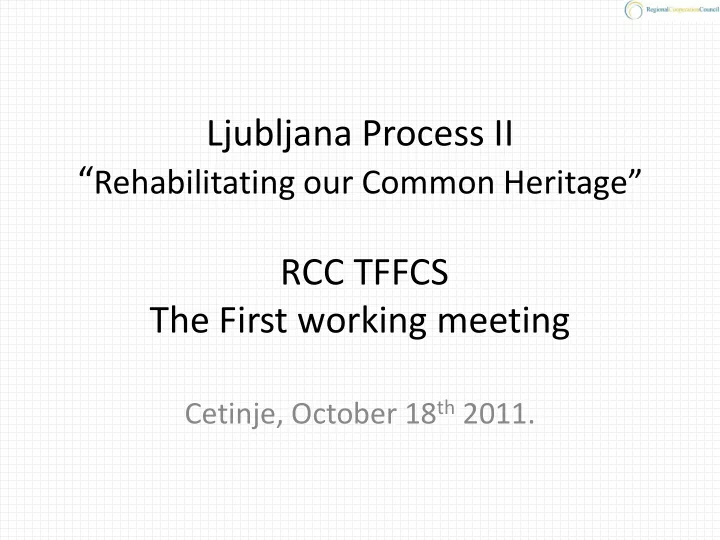

Ljubljana Process II “ Rehabilitating our Common Heritage ” RCC TFFCS The First working meeting Cetinje, October 18 th 2011.
General Reference Framework Draft
General Reference Framework Why it is important for us ? To implement it to improve our practice to develop our projects in accordance with objectives to monitor and evaluate the process to report about progress To use it as a tool to create national strategic documents
General Reference Framework - from a process to a project Basic document of the LP II Structural document Connecting other documents (action plans, reports) Including necessary methodological tools
GRF From process to project General objective Specific Objectives Outcomes Results Activities Methodological Tools Actions Tasks
GRF Content (I) 1.0 BACKGROUND AND DESCRIPTION 1.1 Introduction 4 1.2 Overall objective 4 1.3 Specific objectives 4 1.4 Beneficiaries 5 1.5 Description 5 1.6 Expected Outcomes 6 1.7 Conditionality and sequencing 7 2.0 ORGANISATION 2.1 Main Stakeholders 8 2.2 Management Structure and Responsibilities 8 2.2.1 Executive international bodies 8 2.2.2 Executive national bodies 10 2.2.3 Advising body 11 3.0 IMPLEMENTATION (METHODOLOGY, RESULTS EXPECTED, ACTIVITIES) 12 3.1 Methodology 12 3.2 Results expected 14 3.3 Activities 18
GRF Content (II) 5.0 APPENDIX: TECHNICAL DOCUMENTS/TEMPLATES 25 5.1 Questionnaire for the Assessment of the Architectural and Archaeological Heritage 25 5.2 Proposed Prioritized Intervention List (PIL) 31 5.3 Preliminary Technical Assessment (PTA) 37 5.4 Feasibility Studies (FS) 52 5.5 Business Plans (BP) 57 5.6 ToR National Task Forces 63
GRF Overall objective of the LP II To contribute to the institutional capacity building in South East Europe in order to consolidate the stability and development of democratic, peaceful and free civil societies, as well as the revitalization of communities.
GRF Specific objectives of LP II a) the creation of a transitional operational framework aimed at developing the IRPP/SAAH methodology; b) the integration of cross-sector practices, stemming from the rehabilitation approach, into national and regional operational management structures and heritage rehabilitation strategies; c) the establishment of permanent regional co-operation mechanisms based on renewed national and international partnerships; d) the set-up of sustainable funding mechanisms, thereby creating synergies between national and international public and private investments.
GRF Activities Activity A: Political, methodological and practical feasibility management Activity B: Elaboration of rehabilitation projects Activity C: Professional capacity and educational development Activity D: Promotion, communication and dissemination Activity E: Follow-up and evaluation
GRF Results Management structures become fully operational New laws/policies are introduced Regional co-operation framework procedures are enhanced Institutionalization of the methodology achieved Rehabilitation of the built heritage Improved professional competencies in the beneficiary countries Increased awareness about the value of built heritage rehabilitation for society Improved visibility of rehabilitation projects Follow-up structures in place Monitoring and evaluation mechanisms in place
GRF Measurable indicators Result 4: Institutionalization of the methodology Rehabilitation projects are prepared and contribute to the social and economic development of the partner countries: • Prioritised Intervention Lists (PILs) are updated each year listing the buildings and sites (including religious heritage of all denominations) of significant heritage importance in each of the South East European countries considered in urgent need of conservation and/or restoration; • Preliminary Technical Assessments (PTAs) for the monuments listed on PIL are published on the buildings and sites, including global cost estimates that will serve to establish full feasibility studies/business plans at a later stage; • Feasibility studies for Consolidated Projects chosen as part of the PIL are prepared and published to stimulate funding and follow-up of the rehabilitation; • Business plans for consolidated projects are prepared and published . Measurable indicators: - Number of Priority Intervention Lists adopted; - Regularity of PIL updated; - Number of PTA prepared and approved; - Number of FS approved; - Number of BP approved; - Number of local authorities included in rehabilitation phase; - Number of NGOs included in rehabilitation phase; - Number of countries having accepted full institutionalization of IRPP/SAAH methodology.
GRF Methodology Assessment and selection of priorities Heritage Assessment Report (see template – Appendix 5.1, p. 25) Prioritized Intervention List (PIL) (see template – Appendix 5.2, p. 31) Elaboration of the rehabilitation projects Preliminary Technical Assessment (PTA) (see template – Appendix 5.3, p. 37) Feasibility study (see template – Appendix 5.4, p. 52) Business Plan (see template – Appendix 5.5, p. 57)
Implementation of the GRF In spite of our sophisticated technology, functioning is not possible without your engagement
General Reference Framework Draft
Recommend
More recommend